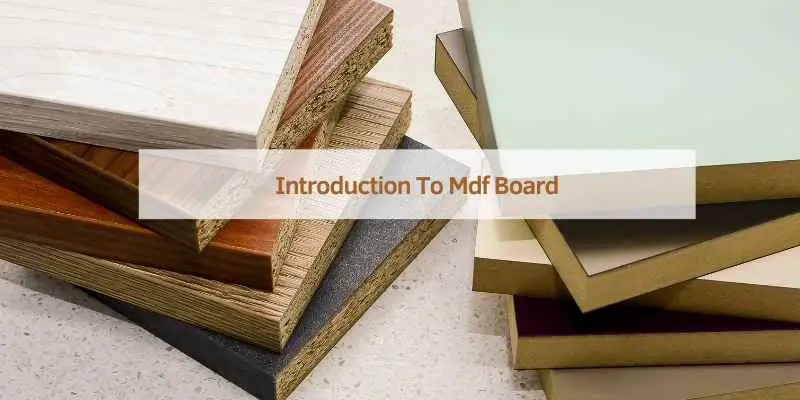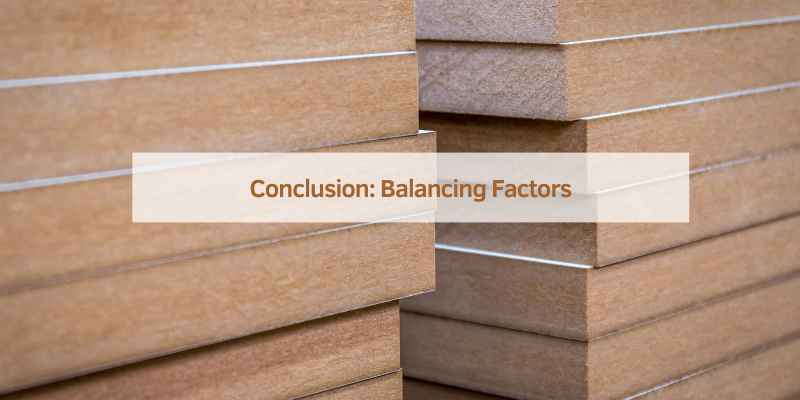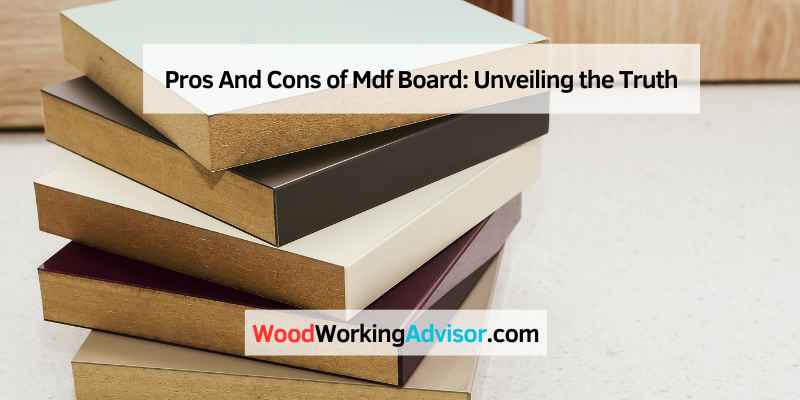MDF boards are affordable and easy to work with, but they lack durability and moisture resistance. They are ideal for indoor projects but not for high-moisture environments.
Medium Density Fiberboard (MDF) is a popular material in the woodworking and furniture-making industries. It is composed of wood fibers bonded together with resin under high pressure and temperature, resulting in a smooth and uniform surface. MDF is cost-effective, readily available, and easy to cut, making it a favorite for DIY enthusiasts and professionals alike.
Despite its advantages, MDF has some drawbacks, such as being prone to damage from moisture and not being as strong as solid wood. Understanding the pros and cons helps in selecting the right material for your projects.
Introduction To Mdf Board
Medium Density Fiberboard, or MDF, is a popular material used in construction and design.
It is engineered from wood fibers, wax, and resin. These materials are combined under high temperature and pressure.
MDF offers a smooth surface and uniform density. This makes it suitable for a variety of applications.
What Is Mdf?
MDF stands for Medium Density Fiberboard. It is an engineered wood product.
Manufacturers create MDF by breaking down hardwood or softwood residuals into wood fibers.
Then, they mix these fibers with wax and a resin binder.
Finally, they apply high temperature and pressure to form panels.
MDF is denser than plywood. It is also stronger and more durable than particleboard.
The smooth surface of MDF is ideal for painting and veneering.
This makes it a versatile material in various projects.
Common Uses In Construction And Design
MDF is commonly used in furniture making. It is also used in cabinetry and shelving.
Its smooth surface allows for easy painting and finishing.
This makes it a preferred choice for decorative projects.
MDF is also used in speaker boxes and interior doors.
It offers good acoustic properties, making it suitable for soundproofing.
Additionally, MDF is used in wall panels and moldings.
Its uniform texture makes it easy to cut and shape.

Advantages Of Using Mdf
MDF, or Medium Density Fiberboard, offers many benefits. It is a popular choice for various projects. Below, we explore some key advantages.
Affordability Compared To Solid Wood
MDF is more affordable than solid wood. This makes it a budget-friendly option for many. It provides a similar look without the high cost.
Cost Comparison Table:
| Material | Cost per Square Foot |
|---|---|
| MDF | $0.50 – $1.50 |
| Solid Wood | $3.00 – $10.00 |
Smooth Finish For Painting And Veneering
MDF has a very smooth surface. This makes it perfect for painting and veneering. There are no knots or grains to worry about.
- Easy to paint
- Ideal for veneers
- No rough patches
Painting and Veneering MDF is straightforward. The smooth surface ensures a perfect finish every time.
Consistent Strength And Durability
MDF is consistent in strength and durability. Unlike solid wood, it does not have weak spots. This makes it reliable for many projects.
- No warping
- Uniform density
- Reliable for heavy use
MDF is also resistant to termites. This adds to its durability and makes it a long-lasting choice.
Environmental Impact Of Mdf
MDF (Medium Density Fiberboard) is a popular choice in furniture and construction. Understanding its environmental impact is important. This helps make informed choices. Let’s explore the pros and cons.
Sustainable Forestry Practices
MDF production often relies on wood from sustainable forests. These forests are managed carefully. Trees are replanted after harvesting. This ensures a steady supply of wood.
Sustainable forestry helps preserve natural habitats. It also reduces the risk of deforestation. This practice supports long-term ecological balance.
Recycling And Waste Management
MDF boards can be made from recycled wood fibers. This reduces the need for new wood. Using recycled materials helps cut down on waste. It also conserves natural resources.
Proper waste management is crucial. MDF waste should be disposed of properly. Some MDF boards can release harmful chemicals if not handled correctly.
Recycling MDF can be challenging. The adhesives used in MDF make recycling difficult. Despite this, efforts are ongoing to improve recycling methods.
Health Concerns With Mdf
Medium Density Fiberboard (MDF) is popular for its affordability and versatility. But there are health concerns associated with it. Understanding these risks can help ensure safer use.
Formaldehyde Emissions
MDF contains formaldehyde, a chemical used in the glue that binds the wood fibers. Formaldehyde is a known carcinogen. This means it can cause cancer. When MDF is cut, sanded, or drilled, it can release formaldehyde gases. These gases can be harmful if inhaled over time.
Here is a table summarizing formaldehyde emission levels:
| MDF Type | Formaldehyde Emission Level |
|---|---|
| Standard MDF | High |
| Low-Emission MDF | Low |
To reduce exposure, use low-emission MDF or seal the MDF surface. This can help to trap the formaldehyde inside the board.
Dust Particles During Fabrication
Cutting or sanding MDF produces fine dust particles. These particles can be harmful if inhaled. They can irritate the eyes, nose, and throat. Long-term exposure can lead to respiratory issues.
Here are some safety tips:
- Always wear a mask when cutting MDF.
- Use goggles to protect your eyes from dust.
- Work in a well-ventilated area to disperse the dust.
- Consider using dust extraction systems to reduce airborne particles.
Following these safety measures can help minimize health risks associated with MDF dust.
The Versatility Of Mdf In Design
The versatility of MDF (Medium Density Fiberboard) in design makes it a popular choice for many projects. MDF is a type of engineered wood product made from wood fibers. It is known for its smooth surface and consistent density. This makes it an ideal material for various applications.
Ease Of Cutting And Shaping
MDF is easy to cut and shape due to its smooth texture and uniform density. Woodworkers can use standard woodworking tools to cut MDF. This makes it perfect for creating intricate designs and detailed shapes.
Unlike natural wood, MDF does not splinter or crack when cut. This ensures clean edges and precise cuts. Carving and routing MDF is also straightforward. This allows for unique and custom designs.
Wide Range Of Thicknesses And Sizes
MDF boards come in a wide range of thicknesses and sizes. This makes it easy to find the right size for any project. Common thicknesses range from 3mm to 25mm. This variety allows for flexibility in design and application.
MDF is available in large sheets, which reduces the need for joints. This results in a smoother and more seamless finish. The wide range of sizes and thicknesses makes MDF suitable for both small and large projects.
| Thickness (mm) | Applications |
|---|---|
| 3mm | Back panels, drawer bottoms |
| 12mm | Cabinet doors, shelves |
| 18mm | Furniture, wall panels |
| 25mm | Heavy-duty furniture, soundproofing |
- Versatility: Suitable for various design projects.
- Uniformity: Provides a smooth and consistent surface.
- Customizable: Easy to cut and shape for custom designs.
- Choose the right thickness for your project.
- Use standard woodworking tools for cutting and shaping.
- Ensure clean edges and precise cuts.
Limitations And Drawbacks
MDF (Medium Density Fiberboard) is a popular choice for furniture and cabinetry. But it has some limitations and drawbacks. Here are some key points to consider:
Susceptibility To Moisture Damage
MDF boards are highly susceptible to moisture damage. When exposed to water, MDF can swell and distort. This can compromise the structural integrity of the board. This makes it unsuitable for areas with high humidity, like bathrooms and kitchens.
Water can cause MDF to lose its strength. Over time, this can lead to warping and deterioration. It’s crucial to keep MDF away from direct water exposure. Proper sealing and painting can help minimize moisture damage. But it doesn’t eliminate the risk entirely.
Weight And Handling Considerations
MDF boards are denser and heavier than plywood. This can make handling and transportation more challenging. It often requires more effort and manpower to lift and move MDF boards. This can add to the overall cost of a project.
Heavier boards can be difficult to work with. This is especially true for DIY enthusiasts. Cutting and shaping MDF requires special tools and more physical effort. This can be a significant drawback for some users.
| Factor | MDF Board |
|---|---|
| Moisture Resistance | Low |
| Weight | High |
| Ease of Handling | Difficult |
Understanding these drawbacks is essential. It helps you make an informed decision about using MDF boards.
Comparing Mdf To Other Materials
Medium Density Fiberboard (MDF) is popular in furniture making and home projects. It is essential to compare MDF to other materials to understand its benefits and drawbacks. Let’s see how MDF stands against plywood and particle board.
Mdf Vs. Plywood
MDF and plywood are both used in construction and furniture making. Here is a comparison of their key features:
| Feature | MDF | Plywood |
|---|---|---|
| Durability | Less durable | More durable |
| Cost | Less expensive | More expensive |
| Water Resistance | Not water-resistant | Water-resistant |
| Surface Finish | Smooth finish | Natural wood grain |
Plywood is stronger and more water-resistant. But, MDF offers a smoother surface for painting and finishing.
Mdf Vs. Particle Board
MDF and particle board are both made from wood fibers. Here is a comparison of their key features:
| Feature | MDF | Particle Board |
|---|---|---|
| Density | Higher density | Lower density |
| Surface Finish | Smooth finish | Rough finish |
| Cost | More expensive | Less expensive |
| Durability | More durable | Less durable |
MDF is denser and stronger than particle board. It also offers a better surface for painting. Particle board is cheaper, but it is not as durable or smooth.
Making An Informed Decision
Choosing the right material for your project can be challenging. MDF (Medium Density Fiberboard) is a popular choice. Understanding its pros and cons helps you make an informed decision. This section explores the cost-benefit and health considerations of MDF.
Assessing Cost-benefit For Projects
MDF boards are affordable. They are cheaper than solid wood. This makes them ideal for budget-friendly projects.
Ease of cutting and shaping is another benefit. MDF is smooth and consistent. It is easy to paint and finish.
| Pros | Cons |
|---|---|
| Affordable | Not as strong as solid wood |
| Easy to cut and shape | Prone to water damage |
| Consistent surface | Heavier than plywood |
Health And Environmental Considerations
MDF contains formaldehyde. This chemical can be harmful. It is important to work in a well-ventilated area.
Dust from cutting MDF can be irritating. Use a mask and goggles for safety. Always clean up dust immediately.
MDF is not eco-friendly. It is made from wood fibers and resin. It is less sustainable than solid wood.
- MDF contains harmful chemicals
- Use safety gear when cutting MDF
- MDF is less eco-friendly
Maintenance And Care For Mdf
MDF (Medium Density Fiberboard) is a popular choice for furniture and cabinetry. It offers a smooth finish and is cost-effective. Proper maintenance and care can extend its life and appearance. Here are some tips to help you keep your MDF looking its best.
Best Practices For Longevity
To ensure your MDF furniture lasts long, follow these simple steps:
- Avoid Excessive Moisture: MDF is sensitive to water. Wipe up spills immediately to prevent swelling.
- Dust Regularly: Use a soft cloth to dust the surface. This prevents the buildup of dirt and grime.
- Use Mild Cleaners: A damp cloth with mild soap is best for cleaning. Avoid harsh chemicals that can damage the surface.
- Protect from Heat: Keep hot items away from MDF surfaces. Use coasters or heat-resistant mats.
- Apply Sealant: A good sealant can provide extra protection. It helps to prevent water and stain damage.
Repairing Damaged Mdf
Even with the best care, MDF can get damaged. Here are some tips for common repairs:
- Filling Small Holes: Use wood filler to fill in small holes. Sand the area smooth once it dries.
- Fixing Scratches: Minor scratches can be fixed with a touch-up pen. Match the color to your MDF for the best results.
- Repairing Swollen Areas: If water damage causes swelling, sand down the area. Then, apply a new coat of paint or sealant.
- Replacing Edges: Edge banding can peel off over time. Reapply with wood glue and press firmly until it sticks.
By following these maintenance tips, you can keep your MDF furniture looking new and extend its life. Regular care and timely repairs are key to maintaining the beauty of MDF.
Conclusion: Balancing Factors
The choice of MDF (Medium Density Fiberboard) for various projects requires careful consideration. By weighing the pros and cons, you can make informed decisions that align with your needs and goals.
Summarizing Pros And Cons
MDF board offers several advantages and disadvantages. Here’s a quick summary:
| Pros | Cons |
|---|---|
|
|
Future Of Mdf In Industry
MDF’s role in the industry is evolving. Advances in technology and materials could improve its properties. Innovations may address current limitations, making MDF more versatile. Sustainable practices in manufacturing might enhance its appeal. The demand for cost-effective and eco-friendly materials will likely drive its growth.
Balancing the factors of cost, durability, and ease of use is essential. Evaluating the specific needs of each project will help in choosing the right material. MDF offers many benefits but also has drawbacks. Understanding these can lead to better decision-making for your projects.

Frequently Asked Questions
What Are The Disadvantages For Mdf?
MDF is less durable than solid wood. It can swell with moisture exposure and lacks natural wood grain.
When Should You Not Use Mdf?
Avoid using MDF in humid or wet areas. It swells and warps with moisture. Unsuitable for heavy load-bearing structures.
What Are The Problems With Mdf Board?
MDF board can be prone to water damage, sagging, and warping. It emits formaldehyde, which can be harmful. It’s also less durable than solid wood and can be difficult to repair.
How Long Will Mdf Board Last?
MDF board can last up to 10 years or more with proper care and indoor use. Avoid moisture exposure.
Conclusion
MDF board offers both benefits and drawbacks. It’s affordable and versatile but lacks durability compared to solid wood. Consider your project’s needs before choosing MDF. With proper care, it can be a cost-effective choice for many applications. Evaluate its pros and cons to make an informed decision for your next project.


